उद्धरेदात्मनात्मानं नात्मानमवसादयेत् |
आत्मैव ह्यात्मनो बन्धुरात्मैव रिपुरात्मन: ||
[Translation: “Let a man be lifted up by his own self; let him not lower himself;
for he himself is his friend, and he himself is his enemy.”]
The partition of Bharat, also known as India, and the inception of Pakistan based on religion in 1947 sowed the seeds of sponsored terrorism against the former. Over the last three decades, Pakistan has sponsored terrorism into Bharat to destabilise the Union Territory (UT) of Jammu and Kashmir (J&K) and other parts of the country. In 2022, Bharat did not witness any major terrorist attack in any of its theatres; however, the terrorism-related incidents, including arrests, surrender, and gun-battle, do shape up the trends and provide a platform for projections for 2023.
The write-up Terrorism/Extremism Trends in Bharat: Review of 2022 and Projections for 2023 aims to summarise the significant terrorism-related events in 2022 and their expected effects on the year 2023. This write-up is the first segment of the review of terrorism-related developments, and the second segment will focus on the terrorism trends in the rest of the world (international). The study focuses on trends that have been reported in five main theatres: i) UT of J&K, ii) Left-Wing Extremism (LWE), iii) Insurgency in North-East States, iv) Islamic Extremism (excluding activities in J&K), and v) Punjab/Khalistan-inspired Extremism. Followed by the prognosis for 2023, the last part of this write-up includes the trends of non-traditional threats, such as drone sightings along the International Border (IB) areas of J&K and Punjab.
The Union Territory of Jammu and Kashmir
On 05 August 2019, the Government of India repealed Articles 370 and 35A, and the State was reconstituted as the Union Territory (UT) of Jammu and Kashmir (J&K) on 31 October of the same year. The coordination of security forces in the Valley has significantly improved since 2019. The UT of J&K did not witness any major terrorist attack post-Pulwama attack, and many terrorists, including key commanders of terror groups, have been eliminated from the Valley due to Bharat’s ‘zero-tolerance policy’ toward terrorism.
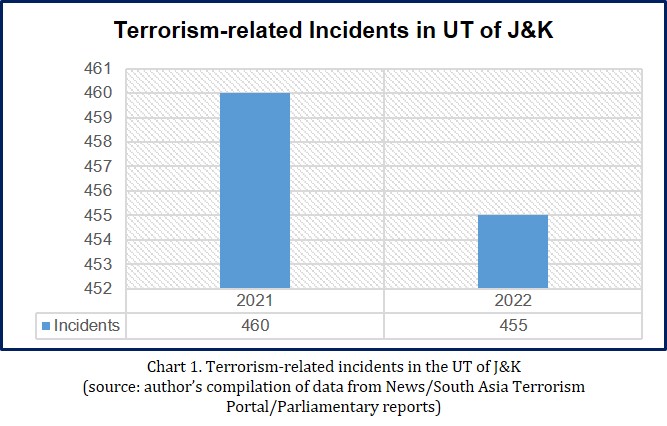
As per Chart 1, the number of terrorism-related incidents in J&K in 2022 decreased by five counts compared to 2021. The total number of terrorism-related incidents, including arms snatching, kidnapping, and others, was 455 in 2022, whereas in 2021, the numbers were 460. From a counter-terrorism (CT) perspective, 2022 was the most successful year. According to the numbers shared by the Director-General of Police (DGP) of J&K police— Dilbagh Singh, “in 2022, 186 terrorists were neutralised; out of which 56 were Pakistani nationals.”[1] As shown in Chart 2, in 2022, the total number of arrests incidents was 331 and 159 terrorists were arrested in various operations.
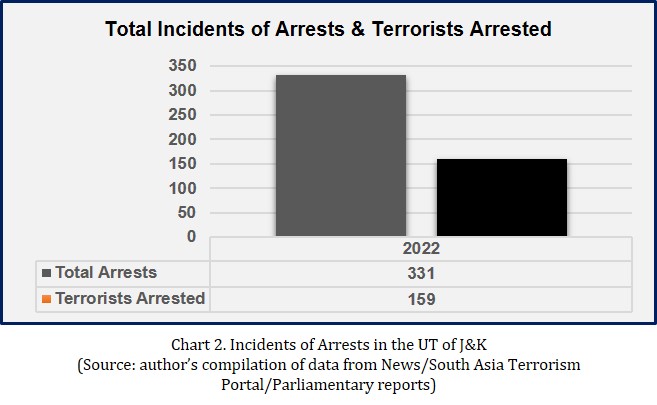
The J&K police also crackdown on 146 Pakistan-created terror modules tasked to carry out specific target killings and IED (Improvised Explosive Device) attacks.”[2] Regarding the recruitment of locals in terror groups and survival rate, the CT operations have cut down the lifespan or survival of newly recruited terrorists. In 2022, there was a 37 per cent decline in new recruitments into various terror groups. According to the data shared by the Additional Director General of Police (ADGP) of Kashmir— Vijay Kumar, in total, 100 new recruitment into various terror groups, 65 were neutralised in CT operations, 17 terrorists were arrested, and 18 terrorists are still active in the Valley.[3] Within the first month of joining, 58 (approximately 89 per cent) of newly recruited terrorists were neutralised or killed.[4]
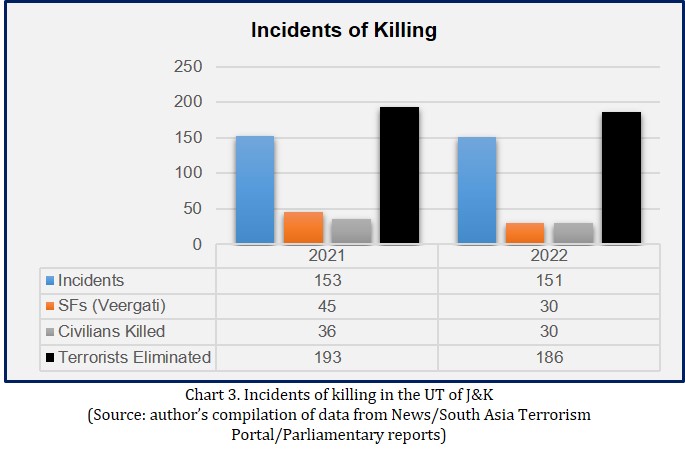
Referring to the data in Chart 3, the decrease in the number of security forces personnel attaining Veergati (who died in battle) highlights significant improvements in training and the effective implementation of counter-terrorism (CT) strategies in operations. Out of the total number of terrorists neutralised in 2022, 172 terrorists, including 42 foreign/Pakistani, were eliminated in Kashmir.
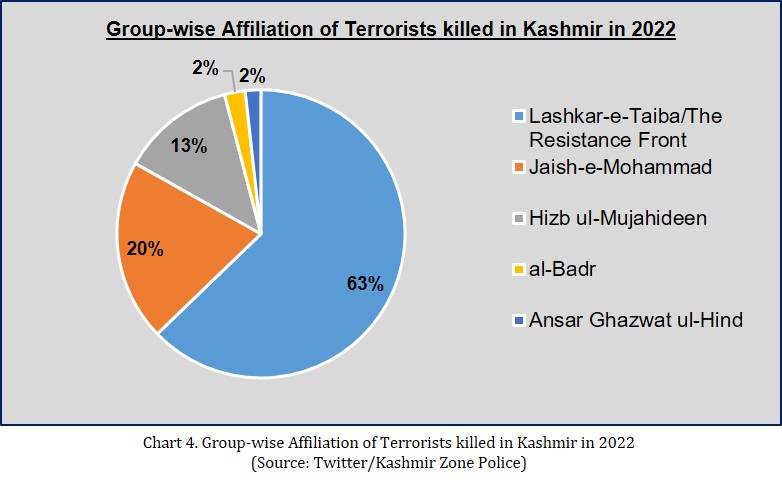
As per the data shown in Chart 4, out of 172 terrorists killed in Kashmir, 108 terrorists (around 63 per cent) belonged to Lashkar-e-Taiba (LeT), and its off-shoot— The Resistance Front (TRF), 35 terrorists (20 per cent) were of Jaish-e-Mohammad (JeM), 22 terrorists (around 13 per cent) belonged to Hizb ul-Mujahideen (HM), 04 terrorists (02 per cent) of al-Badr, and 03 (around 02 per cent) were affiliated to Ansar Ghazwat ul-Hind (AGuH).
The National Investigation Agency (NIA) registered 105 cases involving terror funding in 2022, with 876 suspects facing charges in 94 instances. In terror funding instances, about 100 charge-sheeted suspects have been convicted.[5] Due to the opening of new branch offices across Bharat over the past three years, as well as the inclusion of new offences related to Non-Traditional Security (NTS) threats, such as human trafficking, the production or sale of illicit weapons, drug trafficking, and cyber-terrorism, the NIA’s investigation capacity and efficiency have improved. Overall, the UT of J&K witnessed improved security conditions on the ground, where people in the UT of J&K are protected by well-organised security and intelligence grids.
Left-Wing Extremism
Left-Wing Extremism, also known as Naxalism, led by the banned organisation— the Communist Party of India (Maoist) or CPI (Maoist), has carried out attacks on security personnel and civilians in India. The group— CPI (Maoist) and all of its manifestations are banned under India’s Unlawful Activities (Prevention) Act [UA (P)[A], 1967, and they are all included on the Schedule of Terrorist Organisations. Among the States with varying degrees of LWE exposure are Chhattisgarh, Jharkhand, Odisha, Bihar, West Bengal, Andhra Pradesh, Telangana, Maharashtra, and Kerala. The “National Policy and Action Plan to handle LWE”, which the Government of India authorised in 2015, envisions a multifaceted approach that includes developing security measures, development initiatives, safeguarding rights and entitlements of local people, etcetera.
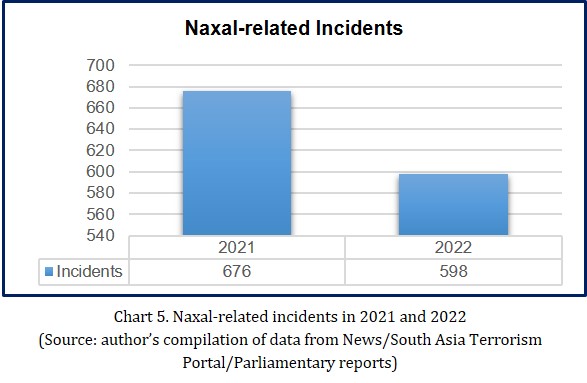
As shown in Chart 5, in total, 598 Naxal-related incidents were recorded in 2022 compared to 676 incidents in 2021. The decrease in Naxal-related incidents can be also attributed to the security forces’ more significant presence, improved operations tactics, and welfare programmes initiated by the Central and State government for those residing in LWE-affected areas.
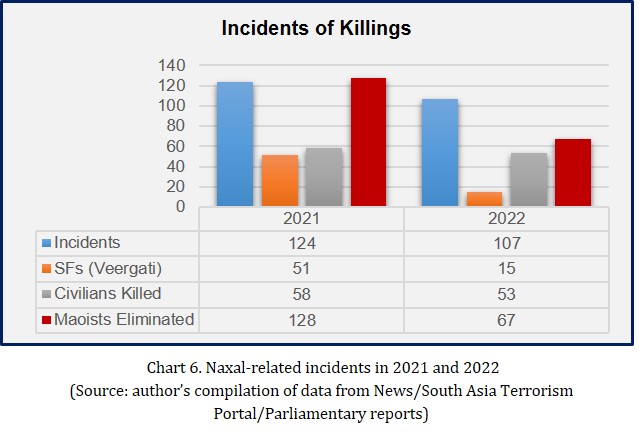
Chart 6, Naxal-related incidents in 2021 and 2022, summarises the occurrences where security forces and Maoists/Naxalites engaged in gun-battle, along with the fatalities that resulted from those incidents. The number of security forces personnel attaining Veergati, the number of civilians killed in attacks by Maoists, and the number of Maoists killed during anti-Naxal operations in LWE-affected areas have all significantly decreased in 2022.
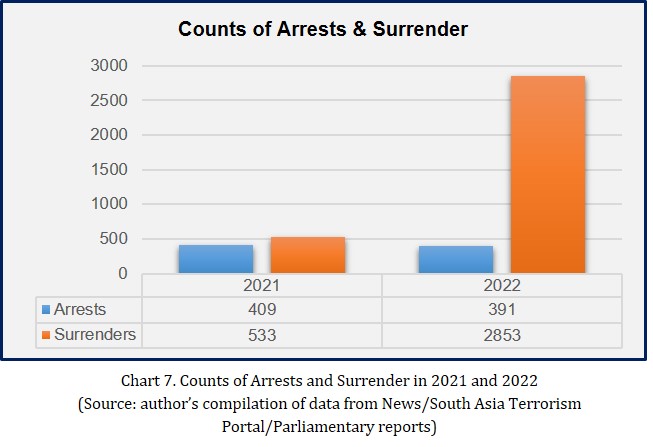
The data on Maoists arrested and surrendered in 2021 given in Chart 7 shows a slight decline in the counts of arrest— from 409 in 2021 to 391 in 2022, whereas in the counts of Maoists surrendered in 2022, there was a steep rise of approximately 435 per cent with 2,853 Maoists surrendering as compared to 533 surrenders in 2021. The increase in the number of Maoists who have turned themselves in and been apprehended illustrates the successful operational tactics being used locally to persuade ‘brainwashed’ Maoists further to stop using violence and join welfare programmes for the advancement of society.
With assistance from the Central government, the State governments of LWE-affected regions have been working continuously to put many welfare schemes into place, which has helped to address the LWE issue. In addition to the flagship programmes of several ministries, there are also specific programmes in place for LWE-affected areas, with a focus on strengthening telecommunications, expanding the road network, empowering education, and financial inclusion.[6]
Insurgency in North-Eastern States
The Central government supplements the state government’s efforts to curb the illicit activities of insurgent groups operating in North-Eastern states through various measures. Insurgent groups, such as the United Liberation Front of Asom (ULFA), National Democratic Front of Bodoland (NDFB), Meitei Extremist Organisation of Manipur, including United National Liberation Front (ULFA), The People’s Revolutionary Party of Kangleipak (PREPAK), Kangleipak Communist Party (KCP), All Tripura Tiger Force (ATTF), National Liberation Front of Tripura (NLFT), National Socialist Council of Nagaland (Khaplang), are proscribed as Unlawful Associations under Section 3 of the UA(P) Act, 1967.[7]
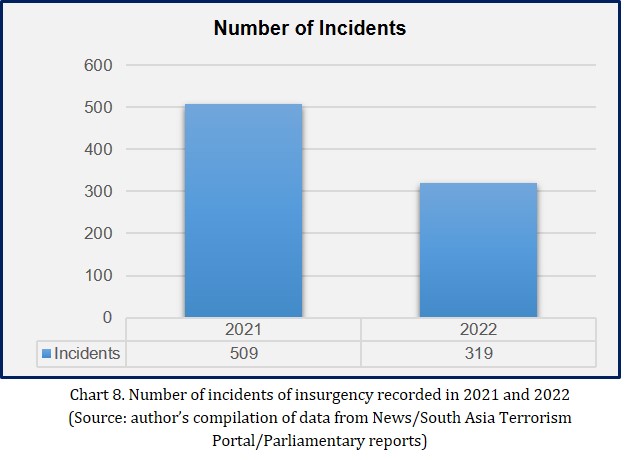
Chart 8 shows a decline in insurgency-related incidents in the North-Eastern States of Bharat. In comparison to 509 incidents recorded in 2021, 2022 had 319 incidents.
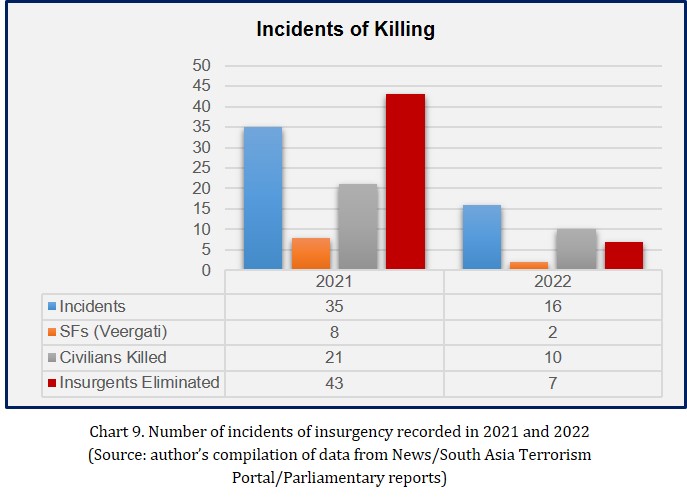
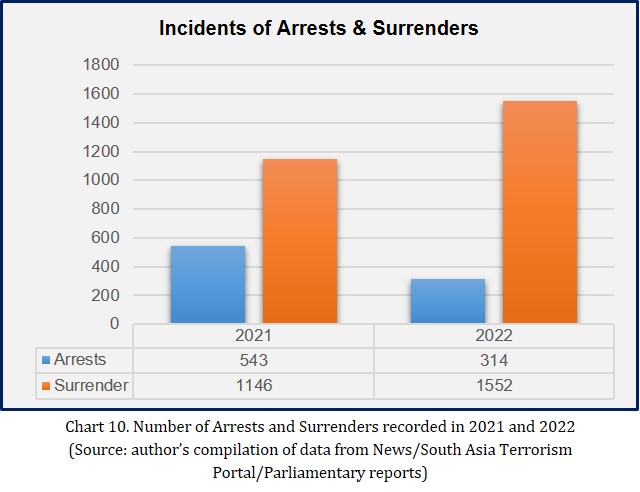
Charts9 and 10 depict the number of killing incidents and the number of arrests & surrenders that took place in 2021 and 2022, respectively. The declining rate of insurgents killed and arrested in 2022 highlights the significant and successful approach of the Central government in dealing with the complex issue of insurgency in the North-East region. With the policy of talks with insurgent groups, several insurgents lay down their weapons and seek peaceful solutions by joining the mainstream. In 2022, around 1,552 insurgents surrendered, whereas it was 1,146 in the previous year.
The Union Ministry of Home Affairs (MHA) has been implementing a welfare scheme for surrender-cum-rehabilitation of insurgents providing monetary assistance and vocational skills training, among other benefits. As a result of the scheme, several operatives of various insurgent groups have surrendered and joined the mainstream. Seeking a peaceful solution, many insurgent groups and their off-shoots have entered into Suspension of Operations (SO), whereas some have signed a Memorandum of Settlement (MoS) to end the violence.
Islamic Extremism (excluding terrorist activities in UT of J&K)
The issue of Islamic extremism in Bharat is sponsored mainly from across the border in the West and inspired by transnational terrorist organisations such as al-Qa’ida and Islamic State (IS), where efforts have been made to radicalise people using misinterpretations of religious texts and through the propaganda by terror groups disseminated on social media via the Internet.
Despite having the world's second-largest Muslim population and the presence of radical ideology, al-Qa'ida and the Islamic State (IS)/Daesh/Islamic State of Iraq and Syria (ISIS) failed to leave a significant footprint in India; however, the terror group has repeatedly threatened India. In 2016-2017, the IS lost control of controlled areas in Iraq and Syria. Since then, the group has been attempting to expand through linked groups in Africa and Afghanistan and preparing for attacks in these countries, following their fictional vision of the so-called ‘global caliphate’.
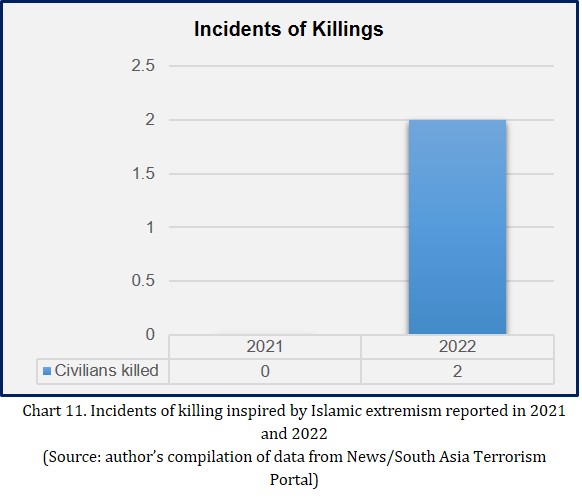
As shown in Chart 11, in 2022, two civilians were killed in attacks inspired by Islamic extremism. On 21 June 2022, two assailants slit the throat and killed an Amravati-based pharmacist— Umesh Kolhe, over his support of the statement made by Nupur Sharma about the prophet Mohammad. Along with seven other conspirators involved in the murder of Kolhe, police arrested the perpetrator— Irfan Khan and located the knife used as a murder weapon.[8] Seven days after the murder of Umesh Kolhe, on 28 June 2022, two Islamic extremists— i) Muhammad Riyaz Attari and ii) Muhammad Ghaus, beheaded Kanahiya Lal Teli, a tailor by profession in Udaipur, Rajasthan. Before killing the victim in front of the camera, both assailants conversed with him while pretending to be clients. Later, the duo shared the murder video on social media and boasted about their infamous act while holding butcher knives.[9] Kanhaiya Lal Teli was murdered in extreme reaction towards his support and sharing the social media post of Nupur Sharma, whose statement on prophet Mohammad made controversy.
In a well-thought and organised move against Islamist organisations propagating anti-Bharat activities, on 27-28 September 2022, the Government of India banned the Popular Front of India (PFI) and its other associated organisations for five years under the stringent UA(P) Act. It was found that the PFI attempted to incite racial hatred in the nation and has connections to international terrorist organisations like IS.
After an earlier nationwide crackdown on the organisation, the prohibition became effective. Along with PFI, the Rehab India Foundation (RIF), Campus Front of India (CFI), All India Imams Council (AIIC), National Confederation of Human Rights Organisation (NCHRO), National Women’s Front (NWF), Junior Front (JF), Empower India Foundation (EIF), and Rehab Foundation, Kerala, were also placed in the list of organisations outlawed under the UA (P) A.[10]
The National Investigation Agency (NIA), on 29 December 2022, conducted raids at 56 places in Kerala, mainly in Thiruvananthapuram, Kollam, Pathanamthitta, Ernakulam, Alappuzha and Malappuram Districts, that were reportedly connected to the outlawed Islamist organisation— PFI. The NIA searched the homes of seven State Executive Committee members, seven PFI Zonal Heads, and 15 PFI physical training instructors. During raids, NIA officials seized sharp-edged weapons, incriminating material, and digital devices.[11] The search operations were part of an investigation into the organisation’s funding and involvement in money laundering and terrorism. The investigation is still in progress.
Emphasising the importance of international collaboration to counter-terrorism and terror financing, in 2022, Bharat hosted three significant conferences— i) the 90th Interpol General Assembly, ii) the UN Security Council’s Counter-Terrorism Committee (CTC) in late October 2022, and iii) the 3rd ministerial meeting of the ‘No Money For Terror (NMFT)’ in November 2022. In order to prevent the use of new technology by terrorists, the UNSC CTC unanimously endorsed the “Delhi Declaration”. In contrast, the NMFT came out with an integrated way for the world to address this menace, in alignment with Bharat’s ‘Zero Tolerance Approach against Terrorism’. The continual flow of funds and cash used to finance terrorism is one of the most challenging phenomena worldwide.
Punjab/Khalistan-inspired Extremism
In 2022, Punjab witnessed the growth of well-organised criminal gangs engaged in various illicit activities, including targeted killings, extortion, abuse of narcotic substances, and other anti-national activities. On 15 April 2022, a pro-Khalistan organisation based in the United States, Sikh For Justice (SFJ), issued a letter titled ‘Haryana Banega Khalistan’ (Haryana will become Khalistan), in which the outfit’s leader and founder— Gurpatwant Singh Pannun, claimed that “Punjab has right over Haryana. To demonstrate this right, the Khalistan flag will be raised at the District Commissioner's office in Gurugram, Haryana, on 29 April 2022.”[12] The SFJ is a proscribed terrorist organisation under the Unlawful Activities (Prevention) Act 1967.
On 09 May 2022, unidentified terrorist(s) fired a Rocket Propelled Grenade (RPG) at a distance from the main entrance of Punjab Police’s Intelligence Headquarters in Sector 77, Sahibzada Ajit Singh (SAS) Nagar, also known as Mohali district in Chandigarh. As reported, there was no report of any injury or casualty caused by the attack.[7] In October 2022, Punjab police arrested the attacker— Charat Singh, a key operative and associate of Canada-based Khalistani terrorist— Lakhbir Singh, from Mumbai.[14]
In Punjab, the emerging situation of violence and targeted killings is causing widespread concern among people about a recurrence of the terrible period of the 1980s in which Pakistan-sponsored insurgency wreaked havoc on the state and caused enormous misery to the people. In recent years, the SFJ, supported by Pakistan’s Inter-Service Intelligence (ISI) Directorate, has been leveraging the tenuous law and order situation under the ruling State government, not only in Punjab but also among the Sikh Diaspora abroad. The present questionable Law & Order situation in Punjab gives an opportunity to pro-Khalistan terrorists such as Gurpatwant Singh Pannu and his Sikh for Justice (SFJ) organisation, Simranjit Mann and Amritpal Singh, along with many others, who are being provided with finances to keep the pot boiling in Punjab.
Tirelessly working on its ‘K2— Kashmir and Khalistan’ theory against Bharat, Pakistan’s ISI Directorate directs the organised crime operatives or drug traffickers to transport narcotic substances in Punjab. As of modus operandi, the drug smugglers working under the aegis of ISI throw the packages containing narcotic substances over the border fence in areas where infiltration is not suspected, and their counterparts on this side of the border collect the assignment later.[15] The Border Security Force (BSF) personnel have often discovered and confiscated drug packages. According to the data of 2021 given in the Lok Sabha (the Lower House of the Parliament), around 486.2 kilograms of narcotic substances, including Hemp, Heroin, and Opium, were seized along the International Border (IB) of Bharat-Pakistan in Punjab.[16] Along with the concern of drug trafficking in Punjab, the increased sighting of drones in Punjab at the International Border also pose a security challenge.
As per the available data on drone infiltration at Bharat-Pakistan International Border (IB), between January-September 2022, the BSF detected 171 drones entering the Punjab sector of the IB. According to the BSF and State police personnel, drones deliver ammunition, small arms, and narcotics.[17] On several occasions, drones drop packets of Afghanistan-origin Heroin for illegal trade and financing terror activities in J&K and Punjab.
Prognosis for 2023
The Union Territory of Jammu and Kashmir
Comparative success of counter-terrorism (CT) operations in 2022 has highlighted the improved coordination between the security forces and intelligence agencies in Jammu and Kashmir (J&K). The successful CT operations in the Valley have broken the ‘spine’ of major terrorist groups— LeT, JeM, and HM; however, their affiliated factions or off-shoot terror groups—The Resistance Force (TRF), Kashmir Tigers, and People’s Anti-Fascist Front (PAFF) would continue to pose security challenges in 2023, unless dealt with more stringent CT measures. These shadow groups were created as diversions orchestrated by Pakistan to ease international pressure and avoid getting listed in the ‘black zone’ for supporting terror groups under the Financial Action Task Force (FATF)’s regulations. As Pakistan is out of FATF-Asia/Pacific Group (A/PG) ‘grey zone’, we may expect a rise in terror activities in the Valley.
Left-Wing Extremism
The year 2022 witnessed somewhat mixed but optimistic results in LWE-affected areas. Although the high numbers of Maoists who surrendered or were arrested had given a jolt to the cadre, the Maoists will continue to rebuild their operational capabilities in their areas of dominance. However, in 2023, the Maoist activities may slow down but would still pose a serious security challenge to the forces deployed in LWE-affected areas.
North-East Insurgency
In terms of the North-East insurgency, fatalities fell significantly in 2022. Despite its disorganisation, the Naga armed movement retains various factions, notably the National Socialist Council of Nagaland (NSCN)-Isak Muivah (IM) and others united under the name of the Naga National Political Group (NNPG). The NNPG has indicated its desire to resolve the Naga issue within the framework of Bharat's Constitution, as decided in 2019; however, the group has yet to reach a definitive agreement.
On the other hand, the leader of the NSCN-IM reaffirmed that the organisation would never abandon its fight of six decades and the Naga flag in pursuit of answers to develop a political identity. In 2023, the NSCN-IM will likely continue its political fight and constitute a security threat. The NSCN-IM, however, is under pressure to find a political solution because Nagaland Assembly elections are scheduled for February/March 2023.
Islamic Extremism (excluding the Union Territory of Jammu and Kashmir)
Since the inception of a new branch for South Asia— Wilayah al-Hind in May 2019, Islamic State (IS) has made some claims of clashes with security forces in J&K, with intentions to project its false presence in the Valley. The arrest of IS sympathisers from different parts of India, mainly Kerala and Tamil Nadu, highlights the radicalisation and recruitment of Muslim youth. The arrested IS operatives confessed to the critical role of content on various social media platforms that led to radicalisation. The much-awaited five-year ban on the PFI and its associated organisations is likely to restrict their efforts for anti-Bharat activities. However, as we have seen in the past, the threat may manifest in different forms— the ban on Indian Mujahideen (IM) and the Students’ Islamic Movement of India (SIMI) gave birth to PFI and other such organisations. In 2023, Bharat’s experience in countering terrorism may play a significant role in UNSC’s policies against terrorism; notably, an international consensus on the proposed Comprehensive Convention on International Terrorism (CCIT) is much anticipated.
Punjab/Khalistan-inspired Extremism
The pro-Khalistan activities in Bharat that have continued in2022 may present difficulties for law enforcement and intelligence organisations. The existence of pro-Khalistan content on numerous platforms, including Twitter, Meta/Facebook-owned Instagram, and Facebook, will be a considerable worry despite the ban imposed on the Sikh for Justice (SFJ) and its other manifestations. The SFJ’s so-called ‘Khalistan Referendum’, voting for separate Khalistan abroad, is also a security concern and must be raised with other nations. In 2023, Pakistan’s ISI Directorate will likely try to re-activate sleeper cells that may orchestrate low-level terror attacks in Punjab.
Endnotes :
[1]PTI. “56 Pakistanis among 186 terrorists killed, 159 arrested in J&K in 2022: DGP”, The Times of India, 31 December 2022, accessed on 02 January 2023, available from: https://timesofindia.indiatimes.com/india/56-pakistanis-among-186-terrorists-killed-159-arrested-in-jk-in-2022-dgp/articleshow/96644661.cms
[2]Ibid.
[3]Kashmir Zone Police (@KashmirPolice), tweet, 31 December 2022, 12:06 PM, accessed on 02 January 2023, available from: https://twitter.com/KashmirPolice/status/1609076118149279746
[4]Kashmir Zone Police (@KashmirPolice), tweet, 31 December 2022, 12:10 PM, accessed on 02 January 2023, available from: https://twitter.com/KashmirPolice/status/1609077136710832129
[5]Tiwary, Deeptiman. “Terrorism is biggest human rights violation, Modi govt has zero-tolerance policy: Amit Shah on NIA day”, The Indian Express, 21 April 2022, accessed on 03 January 2023, available from: https://indianexpress.com/article/india/terrorism-modi-govt-zero-tolerance-policy-amit-shah-nia-7879836/
[6]Rai, Nityanand. “Eradication of Left-Wing Extremism”, Parliamentary Report- Rajya Sabha Unstarred Question No. 1647, 21 December 2022, accessed on 05 January 2023, available from: https://pqars.nic.in/annex/258/AU1647.pdf
[7] “Unlawful Associations under Section 3 of the UA(P) Act”, Ministry of Home Affairs, available from: https://www.mha.gov.in/sites/default/files/UnlawfulAssociationsUAPA_16032022.pdf
[8] “Amravati murder: Who was Umesh Kolhe? Why was he killed?” DNA, 03 July 2022, accessed on 06 January 2023, available from: https://www.dnaindia.com/india/report-amravati-murder-over-nupur-sharma-remark-who-was-umesh-kolhe-why-was-umesh-kolhe-killed-2965484
[9] “Udaipur: Tailor beheaded on video over social media posts supporting Nupur Sharma, both accused arrested”, The Financial Express, 28 June 2022, accessed on 06 January 2023, available from: https://www.financialexpress.com/india-news/udaipur-tailor-beheaded-for-social-media-post-supporting-nupur-sharma-video-surfaces/2575719/
[10]Jain, Bharti. “Centre declares PFI ‘unlawful association’ for 5 years”, The Times of India, 28 September 2022, accessed on 07 January 2023, available from: https://timesofindia.indiatimes.com/india/centre-declares-pfi-unlawful-association-for-5-years/articleshow/94492881.cms
[11] “NIA conducts searches at multiple locations in Kerala in PFI case”, National Investigation Agency, 29 December 2022, accessed on 07 January 2023, available from: https://nia.gov.in/writereaddata/Portal/PressReleaseNew/1368_1_Pr.pdf
[12]Chaurasiya, Laxman. “Khalistani flags to be hoisted at DC office of every district of Haryana.., SFJ terrorist Pannu threatens”, News Track, 15 April 2022, accessed on 07 January 2023, available from: https://english.newstracklive.com/news/sikh-for-justice-terrorist-gurpatwant-singh-pannu-mc23-nu764-ta322-1223165-1.html
[13]Deep, Jagdeep Singh and Navjeevan Gopal. “Rocket-propelled grenade attack on Punjab Police Intelligence HQ in Mohali, probe begins”, The Indian Express, 10 May 2022, accessed on 07 January 2023, available from: https://indianexpress.com/article/cities/sas-nagar-mohali/rocket-launcher-attack-at-punjab-intelligence-departments-office-7908899/
[14] “RPG attack on Punjab Police Headquarter: main accused nabbed from Mumbai”, The Indian Express, 14 October 2022, accessed on 07 January 2023, available from: https://indianexpress.com/article/cities/chandigarh/rpg-attack-on-punjab-police-headquarters-main-accused-mumbai-8207099/
[15]Author’s private conversation with a senior Punjab Police official on the basis of anonymity, on 14 October 2022 in Delhi.
[16]https://pqals.nic.in/annex/1710/AU2273.pdf
[17]ANI. “Pakistan use drones to drop drugs, weapons, for reconnaissance in Indian airspace; infringements on rise”, The Print, 26 December 2022, accessed on 07 January 2023, available from: https://theprint.in/india/pakistan-use-drones-to-drop-drugs-weapons-for-reconnaissance-in-indian-airspace-infringements-on-rise/1282656/
(The paper is the author’s individual scholastic articulation. The author certifies that the article/paper is original in content, unpublished and it has not been submitted for publication/web upload elsewhere, and that the facts and figures quoted are duly referenced, as needed, and are believed to be correct). (The paper does not necessarily represent the organisational stance... More >>
Image Source: https://www.google.co.in/search?q=Mod+clears+Pralay+missile+for+induction+in+armed+forces&tbm





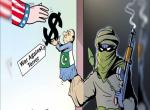

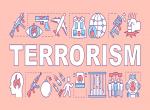
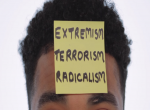
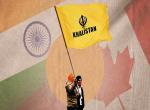

Extremely well written and analysis of terrorism and how the terrorist activities have evolved.
Post new comment